#1860s undergarment
Text



Blue Silk Corset, 1864, British or French.
Victoria and Albert Museum.
#blue#silk#corset#1864#1860s#1860s corset#1860s undergarment#undergarments#1860s extant garment#extant garments#womenswear#19th century#1860s France#1860s britain#British#french#V&A
685 notes
·
View notes
Text

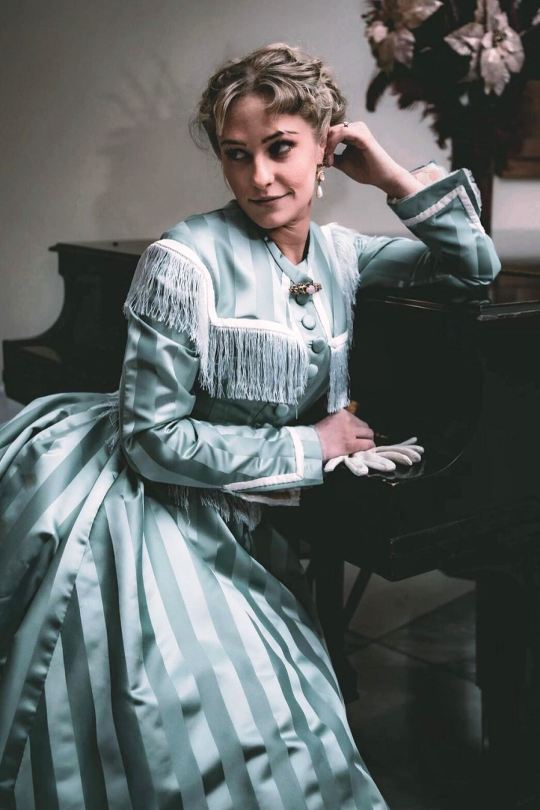
Elise Jean @welldressedhistorian
#blond#vintage blogger#historical fashion#historical undergarments#video#19th century#1860s#victorian fashion#corset#hoop skirts#petticoats#blue#blue dress#stripes#pearl earrings#belted#hat#gloves#white gloves
59 notes
·
View notes
Text

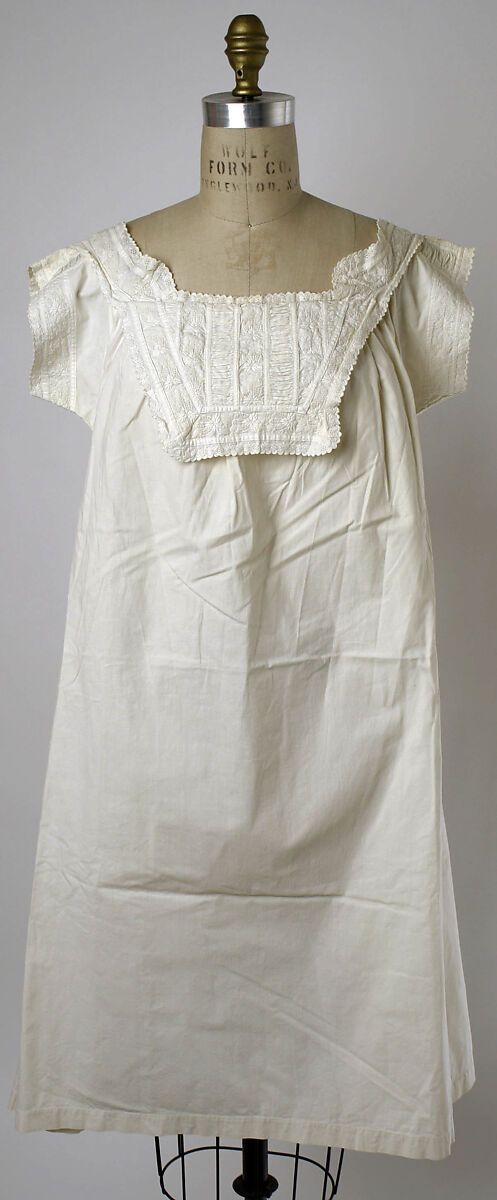

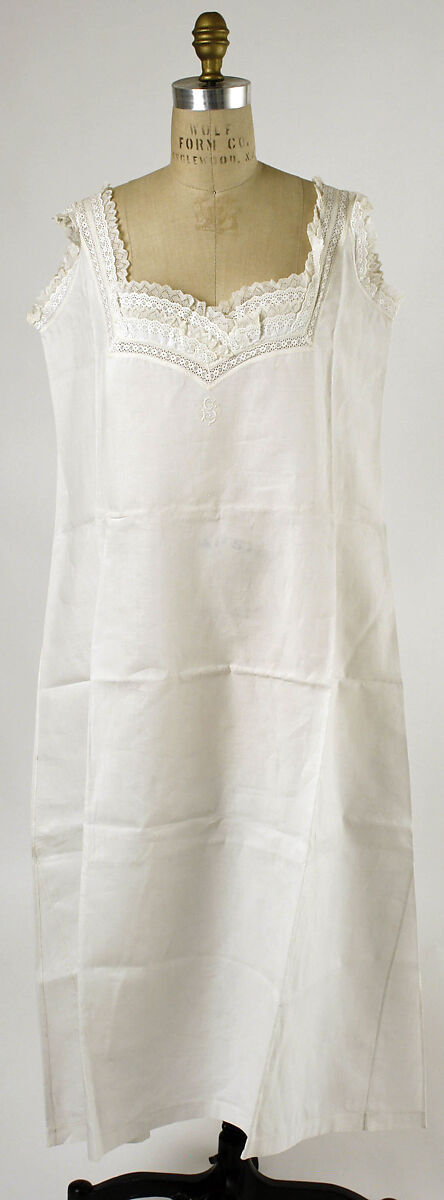
Chemises from 1860-1880
From the collection of the NY Metropolitan Museum of Art
First image: circa 1860 chemise with short cap sleeves, trimmed with scalloped lace at neck and sleeve openings.
Second image: circa 1870 chemise with very short sleeves. Trimmed with eyelet lace at armhole openings and neckline. Closes at center front with a button. Chest features pintucked yoke covered bust area.
Third image: circa 1870 chemise with short sleeves. Embroidered lace at shoulder seam, neckline, and sleeve openings. Front is decorated with panel of embroidered lace.
Fourth image: circa 1880 sleeveless chemise. Trimmed with open lace at armhole openings and around neck. Sweetheart neckline trimmed with wide section composed of many layers of different kinds of lace.
#victorian fashion#chemise#19th century#1800s#1860s#1870s#1880s#lace#undergarments#women's fashion#victorian#victorian era
4 notes
·
View notes
Note
Hello hello! I have gotten myself into an American Civil War era ball in November and I was wondering if you had any input on formal dress from the era! I've never done reenactment before but I would love some input on what I should wear!
That sounds very cool! I hope you'll have great time there when it eventually comes! :D
I'll go through all the garments and accessories that would have been used at the time, but obviously limitations of reality might get in the way of some parts. I'll give my opinion on what I think is more and less necessary to embody the era, but I've never done reenactment either so I can't really say for sure what is the expected level of historical accuracy, maybe someone with some experience of reenactment can chime in. But you'll be the best judge on what you can realistically get/make. Think of this as background info.
So the years we are looking at are 1861-65. I'll start from underlayers towards outer layers.
Shift and drawers
By 1860s drawers were used by most women with their shifts. The shift had wide neckline, small sleeves and often a bit of lace trimming. The sleeves could be wide like in the examples, but less often they might be small poofs. It was roughly knee length and still quite often made from white linen, but white cotton too.
Linen shift from mid 1800s US, and a linen shift from 1861-65.

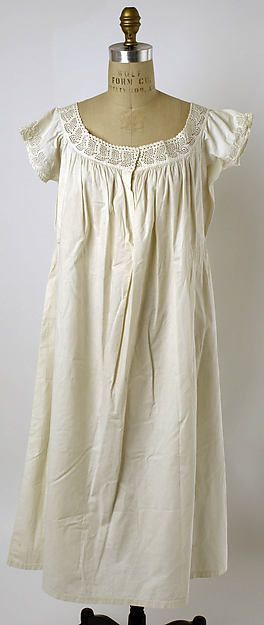
The drawers were very simple in design. They most often split crotch seam, meaning the crotch seam wasn't sewn closed and the waistband was the only thing holding the pieces together. This made it easier to use the bathroom. They reached around mid-calf, sometimes just over the knees, but ankle length was too long. 1860s drawers were very full and usually had simple lace and/or frills at the hem. They were also made from either linen or cotton at the time.
The first example is from 1863 Peterson's Magazine, where pattern for joined drawers are marketed as new, but it's still very much patterned in a way where the drawers don't need to be taken down when using bathroom. It would be still pretty rare. Then drawers from 1860s US.
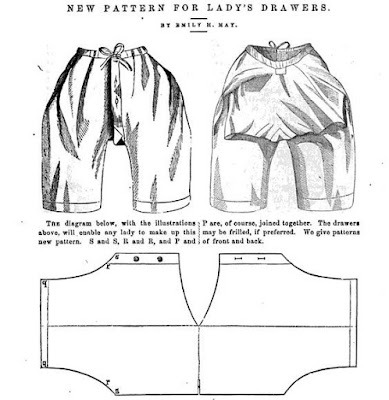

I would say basically any shift with short sleeves and wide enough neckline works here or really in place of that even almost any similarly shaped under dress, but it's very crucial to have something under the corset. If a shift isn't easily available, the replacing dress should be thin so it's not super hot, loose so it doesn't need closures that might cause chafes under the corset and preferably linen or at least cotton, so it's not sweaty and feels comfortable. Linen is really the superior undergarment material as it's anti-bacterial, very breathable and easy to wash, cotton was only contending with it for very Victorian reasons. The drawers are not necessary, not everyone used them at the time. If you don't feel comfortable not wearing any underpants (which was the other option at the time), I do recommend them since using a bathroom with the crinoline and underpants you have to take down is pretty hard.
Corset
1860s corset was fairly short compared to earlier and later corsets, and usually wouldn't reach very far on the hips. It wasn't necessary as the waistline was just above the natural waistline and the skirt was very wide so the shape of the hips would be completely covered. The corset used in formal settings like balls was usually heavily boned but for the same reasons as why the corset itself was relatively short, the bones didn't necessarily reach beyond the waistline. For these reasons even the heavily boned corsets left very large range of movement for the torso. As it was typical for the whole Victorian era, the corset was closed at the front with a busk and had lacing in the back.
The boning was usually just whalebone, metal often only used in the busk. The fabric was reinforced with most often with cotton twill or canvas. Especially in case of these fancier corsets used with evening gowns, the corset often had a silk fashion fabric, which could be white like other undergarments or colorful.
Silk corset from 1864 Britain/France, and cotton wedding corset from 1865-67 US.
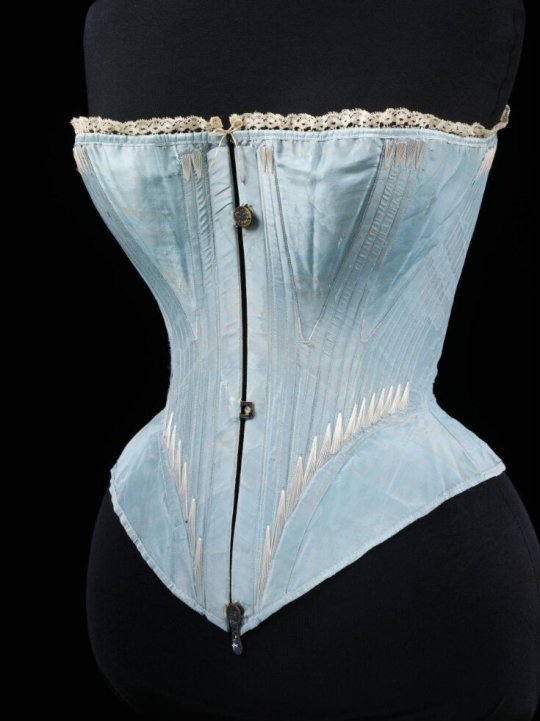
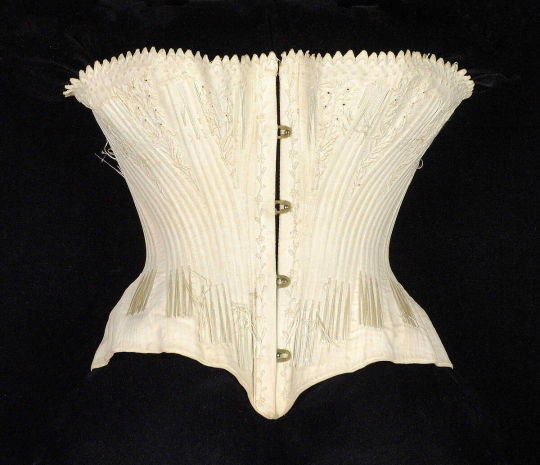
Corset really is very necessary to pull of the ball gown of this era. Not just because it's very crucial in getting the silhouette, but also because it makes it easier to wear the large skirt as the corset distributes it's weight across the torso and supports the torso too. I do think any Victorian corset works here well enough as they are roughly similarly shaped. Because the crinoline is very light, the skirt is lighter than it looks, so even other less structured supportive garments that give even somewhat similar shape could work if Victorian corsets are not an option, like Regency stays or Edwardian corsets or even some modern corset. From what I've heard about reenactment events, I would prioritize having corset (or similar) that fits you and you know you can wear for a long period of time over historical accuracy and the right silhouette. (Corset often needs to be broken in like leather shoes, because the whalebones will shape into the body.)
Crinoline
Crinoline is a crucial part of the underlayers to achieve the silhouette of this era. The silhouette went through some changes even in the first half of 1860s. It started as quite similar to late 1850s silhouette of very large and round, though already in 1861, the volume was more focused in the back. In the following years the skirt would become less round, but wider and the volume would increasingly lean to the back. The skirt would reach it's widest point with massively long back, almost like a very wide bustle, in 1865.
Crinoline from 1860-62 Spain, and another from 1865. You can see the progression quite well between these two.
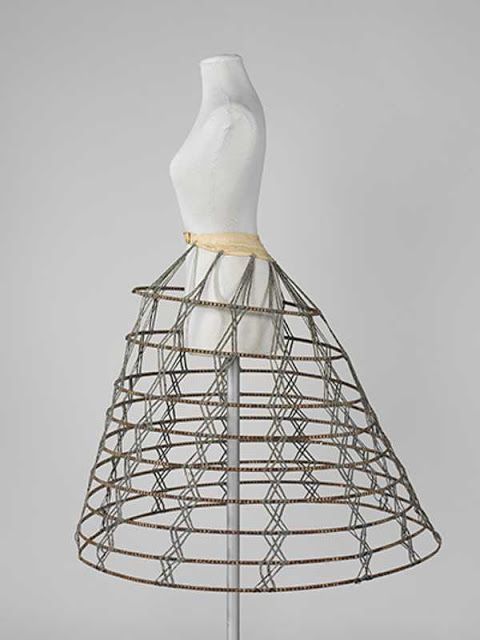

Here's also all of these foundational layers shown all at once, though I think the crinoline is from between 1866-68, since it's so narrow around the hips (the silhouette collapsed very quickly from the critical mass of 1865 to a much more narrow A-lined silhouette).

As said, this is really necessary to pull of the skirt of early half of 1860s. You really can't get the shape right without it. Especially for the earlier silhouette of the decade 1850s crinoline works perfectly fine and even the later 1860s crinoline like above. Even modern or 1950s hoop skirts can be serviceable here, but if the skirt is cut like in the mid 1860s, it definitely does need the elliptical crinoline that are very specific for those couple of years, as you'll see in the examples of the next section.
Petticoat
Petticoat's purpose in this era was mainly to smooth out the crinoline. It was therefore voluminous and usually made out of fairly stiff fabric, usually a bit heavier linen or cotton. There was often horizontal pleats around the hem, which would reinforce the shape. Couple of layers could be used too to properly cover the crinoline. It was pretty plain, usually white, but not necessarily, maybe with a bit of lace at the hem. Especially in early 1860s the petticoat was usually gathered with cartrigde pleats, which give a very round and voluminous shape. Around the mid 1860s, the pleating would be mostly focused in back to enhance the long shape.
Cotton petticoat from 1855-65 US, and linen petticoat from 1860-65 US. The first is very likely late 1855 or very early 1860s as it's so very round. The second is definitely closer to 1865, it shows very well how much more volume was at the back, as the hem there is much longer.
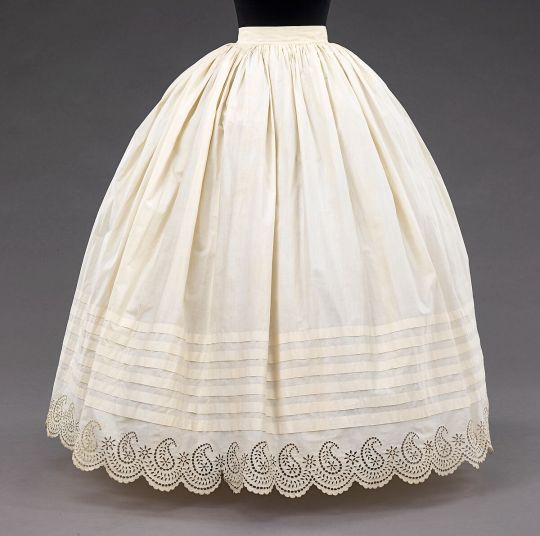

This is not strictly necessary, but it's very obvious when a crinoline doesn't have a petticoat on top of it, especially if the skirt is made out of some thinner fabric. It can be very simple, it just needs to be big enough. Basically any similar sized skirt or petticoat works fine in it's place.
Corset cover
Corset cover or camisole, as the name suggests, had similar purpose as petticoat, to smooth out the hard line of the corset. It was a small shirt, with similar neckline and sleeves as shift at the time. It was like other undergarments almost always white, often made out of cotton, but linen too.
Cotton corset cover from 1860 US, and another from 1864-68 US.
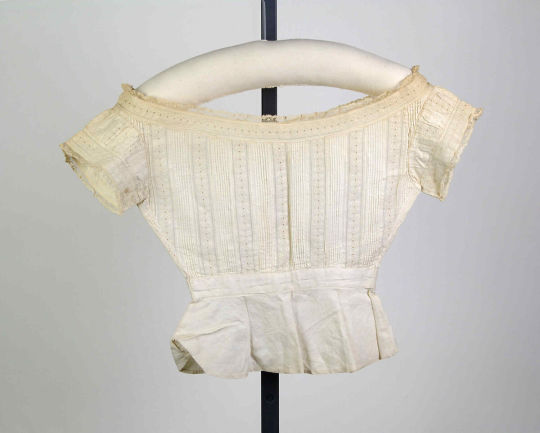
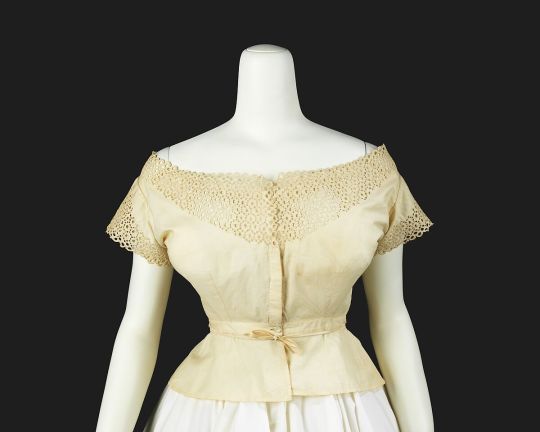
It's not super necessary imo, but it does give a smoother finish. It could be pretty easily replaced by a corset cover from different era, that's close enough in design (so it won't be showing under the bodice), if something like that is more easily available.. Any shirt really that's similarly loose-ish, so that it doesn't create too much bulk, but also doesn't get pinned tense by the bodice, would work I think.
Ball gown
Now we finally get to the meat of it. Ball gowns of the early half of 1860s had very tiny sleeves, that hung just over the shoulder. They were usually tiny poofs or could be tiny frills too. As mentioned earlier, the bodice was short and ended abruptly at the waistline, which was slightly above the natural waist, to emphasize the mass of the skirt. A typical waistline exaggerated pointed end.
The skirt was not as elaborately layered like a cake as in late 1850s, but typically it had a bit of layering at the hem, where the layers were displayed by different types of gathering. An organza layer on top was very popular. A bit of trimming at the hems of the layers of the skirt was common, but the amount of trimmings was pretty restrained (especially when compared to the next couple of decades).
The colors of evening wear were usually light. I've noticed white, light pink, light blue, mint and lavender crop up most often. It was though very trendy to have a dark or a bright jewel accent color combined with the soft dominant color. The new synthetic dyes were able to create cheep bright colors unlike before and people were very into them. The most popular colors, that were also used a lot as accent colors in evening wear were bright purple, magenta, electric blue and emerald green. The evening gowns tended to be solid color and mostly one color too, except for the accents. Typical decorative motifs were fabric flowers, bows, lace trimming and fringes. For evening wear the fabric was most often silk as taffeta or satin and possibly organza in addition.
Here's some select fashion plates with ball gowns I really like. The firs is from 1863 and the other two are from 1865.


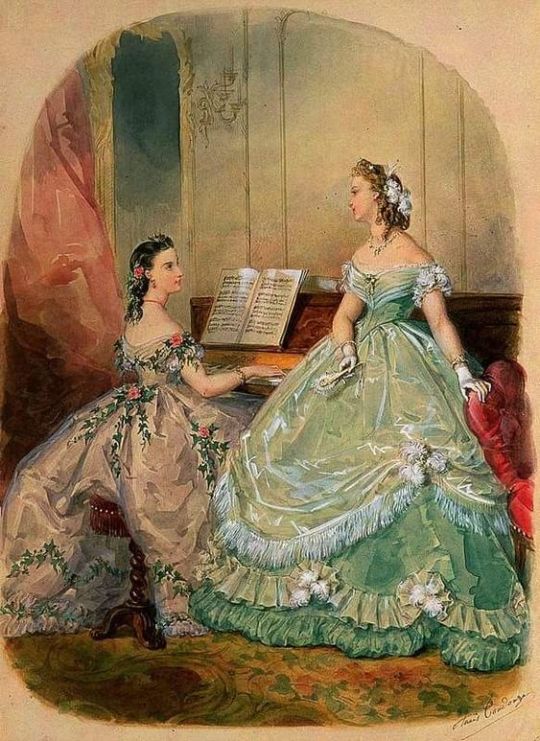
The first two include my personal favorite trend from this period, which is corselette/Swiss waist/Medici waist. It was a small decorative usually underbust waistwear, sometimes with shoulder straps, sometimes without. It was part of the Gothic Revival fashion and was alluding to Renaissance bodices and stays. They really have nothing to do with Medieval or Renaissance fashion, but Victorians associated the use of waistwear and stays as outer wear with vague idea of The Gothic for quite complicated reasons (I talk about that in this post at length). They were lightly boned, but just to keep up the shape, they were not in any way supportive, just decorative. The blue dress in the first example above has a Medici waist (the trend was loosely inspired by Catherine de Medici's portraits), which has the distinctive upward pointed neckline combined with shoulder straps, and the white dress in the second example has either Swiss waist or corselette. The terms were used quite interchangeably, even the Medici waist's definition is pretty loose (I usually just default to corselette). Below there's couple of more example of these. First is silk corselette from 1863-67 US and second is silk corselette from 1864-68 US. The third is a dress with another silk coselette supposedly from 1855 US. I think the bodice is too short for 1855 and the skirt very distinctly mid 1860s, with the volume in the back, so I won't believe MET on this. Interestingly the dress is made out of piña fabric, which is traditional fabric made out of pineapple plant fiber and was a luxury fabric among Western upper crust in 18th and 19th centuries for colonialist reasons.



Okay, I'm done with the corselette propaganda. I have a pinterest board of primary images with a section for 1860-65 for additional inspiration, but I haven't organized it yet, so there might be some misplaced images.
Accessories
These are not that necessary, but a bit of extra detail to sell the look.
Hair was kept in elaborate low buns, which could be decorated with fabric flowers and ribbons for the evening. Necklaces were pretty short and usually fairly simple. This was the time, when the iconic black silk ribbon collar became a thing. In 1860s it usually had some small (or bigger as in this royal example) pendant on it.


Gloves were strictly necessary. For evening they were always white kid (a type of thin leather) gloves, which just covered the wrists. Silk gloves were thought of as tacky. The gloves were very simple in style but bracelets were often used with them.
Above knee stockings were always used. Usually they would be white, but they did come in all kinds of colors and small patters on the ankle were common. They would be knitted silk for the evening. Here's some silk stockings in very fun colors and patterns from 1860s England. They were secured with with a wide silk ribbon tied below or above knee. I use stockings and ribbon to secure it for everyday purposes, and it works really well. The thing is to have wide enough ribbon you can circle around the leg couple of times, so it won't put too much pressure on one spot. For me below knee works the best. Really any thin knee high stockings works for this, and white is the safest bet.

There's some options with the shoes. Both boots and slippers were acceptable for evening wear and slippers could have a heel or not. The evening shoes were less practical and fancier that your day shoes. They usually had silk as the fashion fabric, which wasn't that much of an issue, since they were used indoors.
Silk evening boots from 1860s France, silk slippers with a heel from 1855-65, and silk slippers from 1862 Austria.
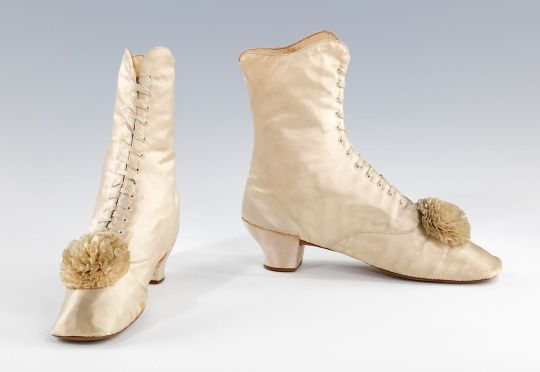
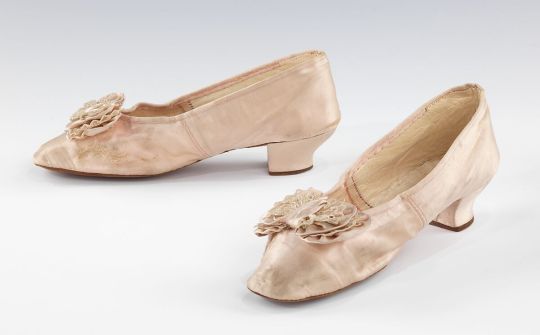
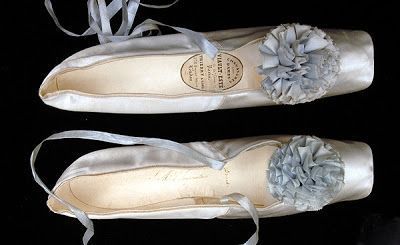
Honestly, shoes won't be really seen under the skirt, so I don't think it's very necessary to get new shoes (there are shoe sellers like American Duchess who do historical reproduction so it's possible). Basically any ballerina slippers with a somewhat flat or at least round end are pretty close. Also any shoes roughly between 1830-1880 are basically accurate (minus some details) as the shoe fashion changed pretty slowly.
I hope this was helpful for at least providing some background info!
#historical fashion#history#victorian fashion#fashion history#dress history#answers#historical costuming#extant garment#1860s fashion#fashion
124 notes
·
View notes
Note
This is a stick up
SHOW ME THE BABY GRILL (dusk)

Very mildly historically accurate circa 1860s ball gown undergarments, since I've been seeing a lot of people talking about historical ghouls and (oops special interest)
I say mildly bc I could point out so many things that would be different or need to be added still but also like, it's a drawing of a demon so why would anyone care 😭 I'm pretty sure there's at least 3 other people who also hyperfixated on fashion history but the majority doesn't
105 notes
·
View notes
Text
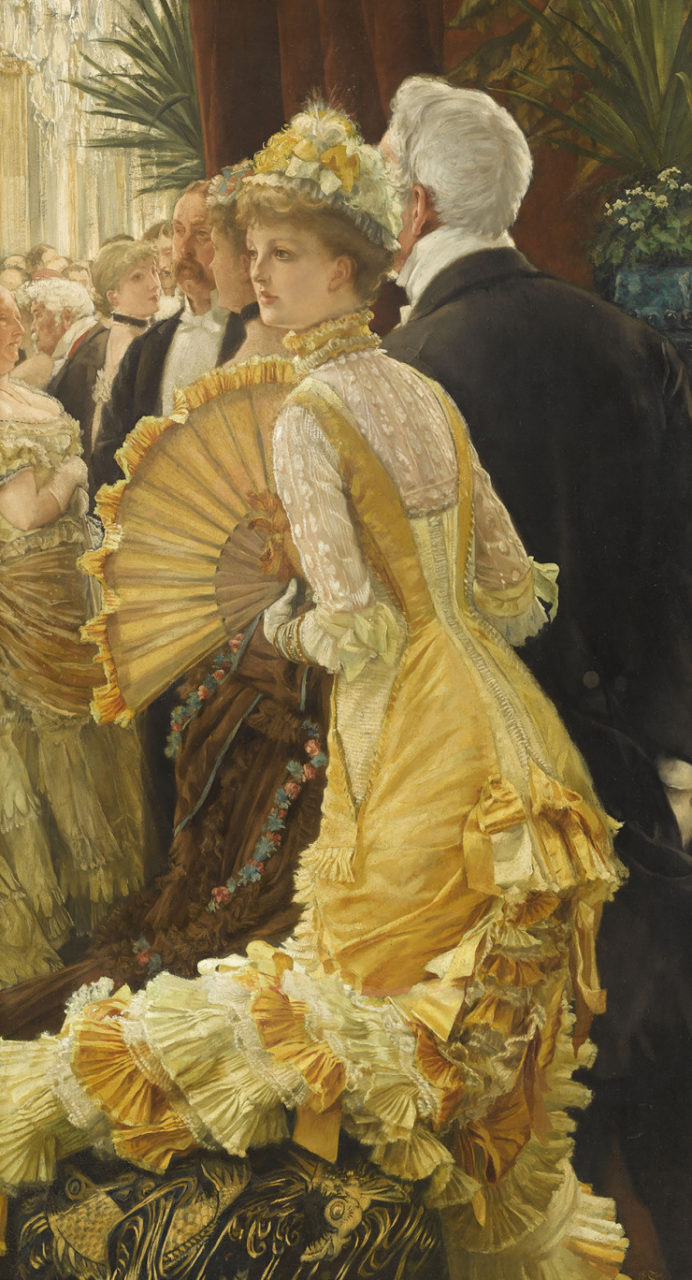
figure 1
James Tissot (French, 1836–1902) • The Ball • 1878
Figure 1: According to French fashionistas, Tissot got the hat all wrong. Apparently hats were inappropriate as evening wear, particularly at a ball. Indeed, when perusing fashion plates of the late 1870s, formal evening attire never included hats.
For formal evening events, hair was styled in elaborate braids, buns, and curls, often adorned with silk flower sprays and fancy clips and combs. Silk flowers were also sometimes used as embellishments for dresses.

A Tissot creation likely inspired by the fashion plates of the day, the evening or ball dress in figure 1 features a bow right at the buttocks followed by a cascade of layered pleats, lace, and ruffles. This style was commonly referred to as The Princess Line dress. Created in Great Britain by Charles Frederick Worth in the form of Princess Alexandra's wedding dress, it soon took off as the latest dress style craze.

French hand fan • Ivory, paper, gouache, mother-of-pearl, metal • 1860-70 • Brooklyn Museum Costume Collection at The Metropolitan Museum of Art

Figure 2
Figure 1: In the mid 1870s, the bustle evolved into a less protruding fashion feature and eventually, toward the end of the decade gave way to the mid-bustle or natural form era. This transformation took place from 1877 through approximately 1882. Compared to the large, overstuffed bustles of the early 1870s, the Mid-Bustle, or Natural Form dress created a more vertical, slimming silhouette. The waist was undefined and embellishments began at the back of the waist, or even below it.
Figure 2: It is difficult for a fashion history novice like me to define the correct occasion for this particular dress. It's perhaps a special occasion day or afternoon dress and hence less embellished. Or perhaps the modest satin bow at the hip gives it away as just a regular day dress. In one entry at Lily Absinthe's blog, she states that a semi-train is usually indicative of a day or afternoon special occasion dress. All I know for sure is that I adore the lovely vertical pleated train!

Princess Line dress • 1878-1880 (made) • Unknown designer and maker, likely from Great Britain • Virginia and Albert Museum
Blue and gold Jacquard-woven silk made with a fitted bodice and narrow skirt drawn back into drapes at the back, and rusched silk trim. It has elbow-length sleeves and a square neckline, which are both trimmed with machine-lace. This is a day or afternoon dress, likely worn at home. More views of this dress can be seen here.

Attire appropriate for a hat.

Of course, the ultra-slim silhouette of the princess dress was restrictive and necessitated increasingly tighter undergarments like corsets and girdles, further restricting movement. Poor working women who engaged in hours of manual labor could not afford either the latest fashions nor the restricted movement.
Sources:
Lily Absinthe
The Metropolitan Museum of Art Costume Institute , New York City
Fashion History Timeline (FIT, Fashion Institute of Technology, New York City
V & A (Victoria & Albert Museum, London
#fashion history#late 1870s fashion history#princess line dress#james tissot#art history#french fashion history#late 1870s fashion plate#french hand fan#victorian fashion#historical fashion#victorian era#19th century fashion#the resplendent outfit blog#french fashion#historical painting
36 notes
·
View notes
Note
Does this actually look like 1869 to you? zegalba (DOT) tumblr.com/post/722385349980094464/french-wedding-dress-1869
I'm confused by it!
here's the pic, for reference:


(It's in the Met Museum's collection right now, so I was able to find more pictures. It is in fact two pieces- unsurprising, since most dresses were back then.)
just in terms of era, yes, I would absolutely buy this for 1869. it's a sheer overdress, meant to go on top of an opaque under-layer (well, okay, several, but besides the wearer's undergarments. you understand), and it reflects a brief late 1860s trend for an almost A-line silhouette:
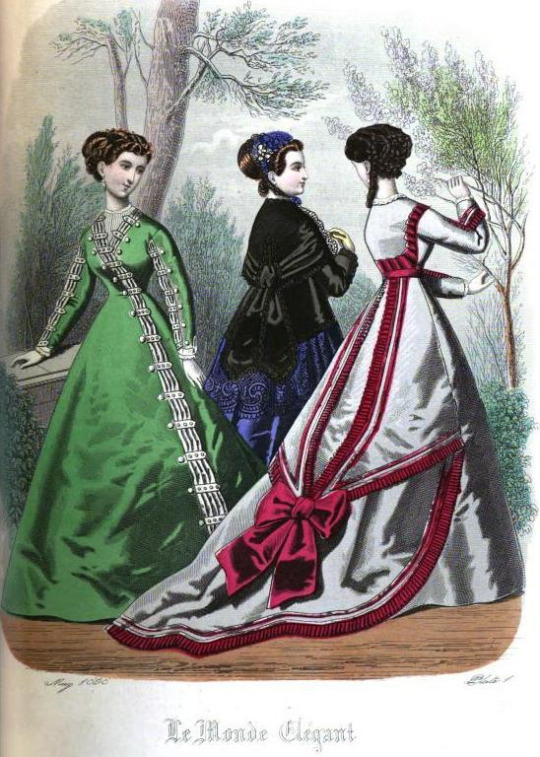
(Le Monde Elegant, May 1868. By 1869 you're starting to see a more proto-bustle look superseding the relatively slim skirts of the previous year, but there's still a version of this silhouette in the fashion magazines.)
Now, the classification of "wedding dress" is one I struggle with, in the case of non-white gowns. My guess is that this piece was donated by a descendant of the original owner, hence the very precise dating and the use designation. Except...our modern understanding of Wedding DressTM tends to be "dress that is immediately recognizable to any outside observer as a wedding gown, regardless of the context in which it is worn." And an overgown like this does not fit that bill. The owner could have continued wearing it for formal occasions, and very likely did, with no-one thinking it was odd or out of place. It's the dress she was married in, sure, but after the wedding it could have been part of her wardrobe as simply A Very Nice Overdress (With Extra Sentimental Value). I don't know if calling it A Wedding Dress properly conveys that to a modern museum-going audience.
But then, I'm broadly opposed to all categorizations of 19th-century non-sporting or lingerie clothing beyond "formal, semi-formal, casual" in museum descriptions, on the grounds that there was little consensus about what separated an "afternoon dress" and a "dinner dress" at the time (for example) and it perpetuates the myth that women changed their clothes a dozen times a day, so. There's that.
(I would have phrased it like "overgown, worn as a wedding dress," but that's just me)
Anyway! Hope this answers the question to your satisfaction.
#long post#dress history#1860s#victorian#marzi rambles#ask#anon#clothing history#fashion history#victorian fashion
106 notes
·
View notes
Text


Today we're talking autumnal harvest dresses, and we're starting with this American number dating from 1867-1860. It's a dress with provenance, and that's always exciting. According to the Met Museum, this was worn by Mrs. James Bonner Collins, who attended a ball at the White House with then president James Buchanan.
This is another transitional period dress, where we start seeing the growth--and growth, and growth!--of skirts. Initially, the volume was achieved through many layers of petticoats. This gave way to more structured undergarments, the sort of crinolines that are now synonymous with the 1860s and Scarlet O'Hara.
I love the very colors here, especially the contrast of the vertical blue stripes with the checked silk floral pattern. The orange fringe is a nice touch, too!
#1860s fashion#fashion history#threadtalk#victorian fashion#historical costuming#silk dress#textiles#costume history#costume
181 notes
·
View notes
Text

'La M. de la Corsets': c. 1832 lithograph showing a dressmaker or tailoress and client. The undergarments depicted include sleeve-plumpers.
1830s Thursday: Big sleeves, and even bigger dreams for women’s rights.
The growing vulnerability of working women in industrial society provoked a forceful response. In 1825 hundreds of them went out on strike against New York City clothing houses. In 1831 these same women organized themselves into a mass-membership United Tailoresses’ Society. At a time when journeymen were still devoting their political efforts to a defense of artisanal prerogatives in the master’s shop, these “tailoresses” (the appellation itself testified to an advanced degree of industrial consciousness, excluding as it did the more traditional dressmaking of the “sempstress”) already understood that in a capitalist economy no aspect of the work relationship remained non-negotiable. [...]
No one can help us but ourselves, Sarah Monroe, a leader of the United Tailoresses’ Society, declared. Tailoresses should consequently organize a trade union with a constitution, a plan of action, and a strike fund. Only then could we “come before the public in defense of our rights.” The Wollstonecraftian rhetoric was conscious. Lavinia Wright, the society’s secretary, argued that the tailoresses’ low wages and hard-pressed circumstances were a direct result of the way power was organized throughout society to ensure women’s subordination in all social relations.
— Michael Zakim, Ready-Made Democracy: A History of Men's Dress in the American Republic, 1760-1860
I was disappointed in my search for pictures of Sarah Munroe, Lavinia Wright, or really anything to do with the United Tailoresses’ Society. One online article outright stated, “We know very little about this speaker, Sarah Monroe, other than that she was a garment worker and president of the newly formed United Tailoress Society -- the first women-only union in the United States.”
I am in awe of this working-class woman, Sarah Monroe, who is quoted by Michael Zakim as saying in 1831:
It needs no small share of courage for us, who have been used to impositions and oppression from our youth up to the present day, to come before the public in defense of our rights; but, my friends, if it is unfashionable for the men to bear oppression in silence, why should it not also become unfashionable with the women?
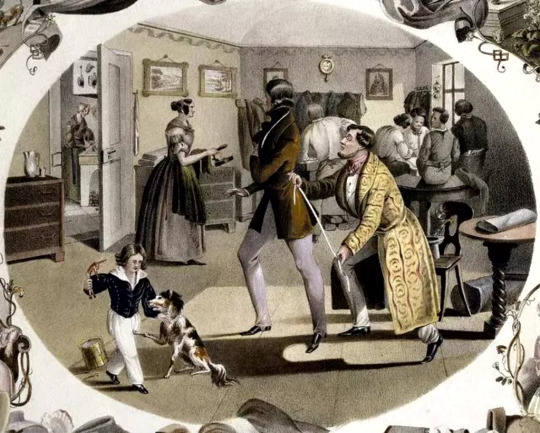
'The Tailor's Shop': 1838 lithograph by Carl Kunz and Johann Geiger
#1830s#fashion history#labor history#labour history#us history#sarah monroe#Eighteen-Thirties Thursday#united tailoresses' society#michael zakim#women's history#also i have been sleeping on michael zakim's book it's really good#there were many strikes by female garment workers in the time period#amazingly forward-thinking they were trying to get sick pay and retirement benefits#they also campaigned against prison labour#tailors#dress history#inequality#industrial relations#19th century
380 notes
·
View notes
Text
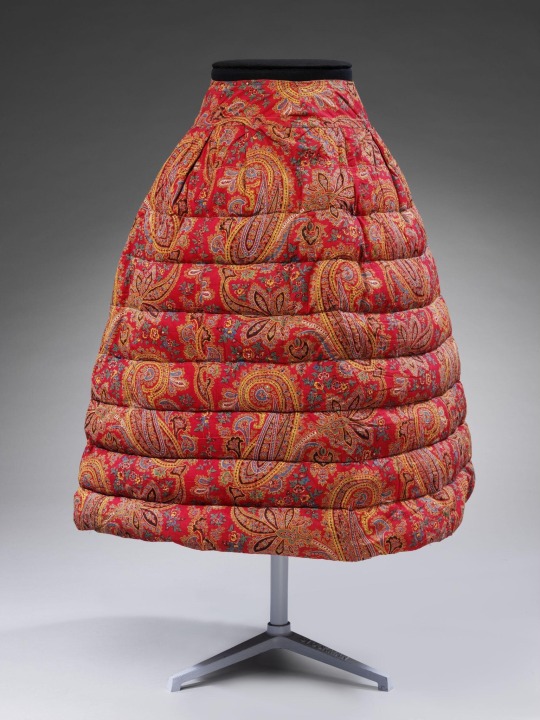
Red Printed Cotton Petticoat, ca. 1860, English.
By Booth & Fox.
Victoria and Albert Museum.
#booth & fox#red#petticoat#1860#1860s#1860s petticoat#1860s undergarment#undergarments#extant garments#womenswear#1860s extant garment#V&A#1860s England#1860s britain#British#English
101 notes
·
View notes
Photo
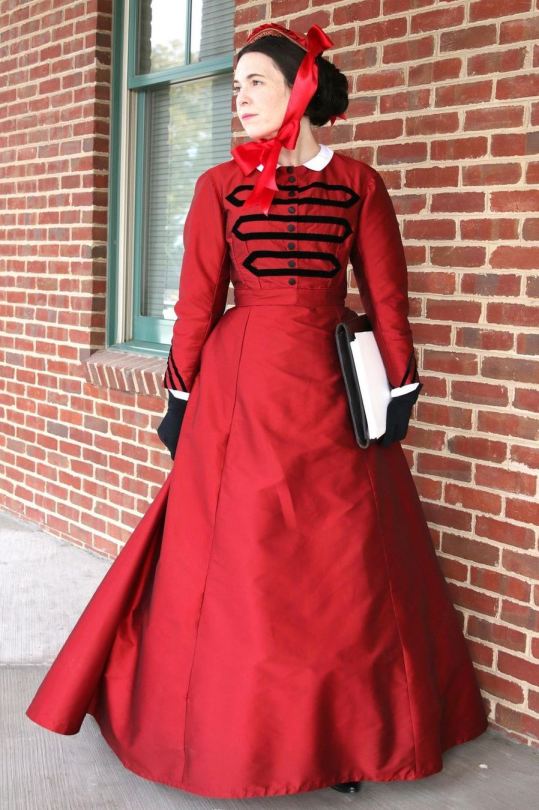


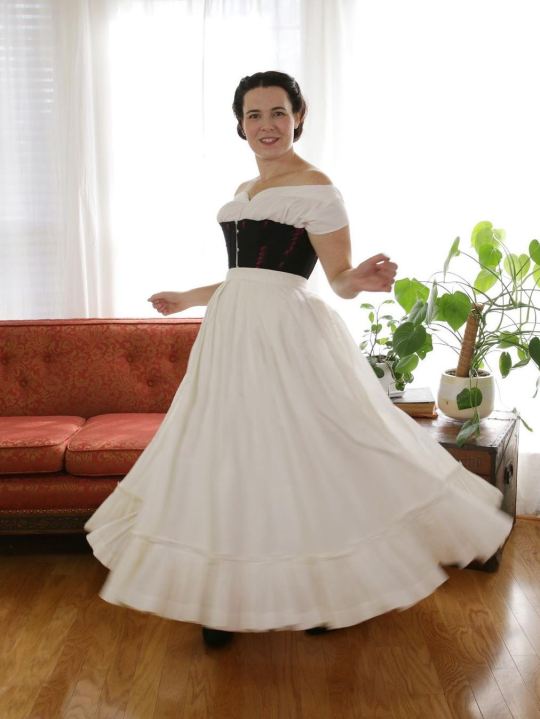
@dixiediy
#dark hair#vintage blogger#victorian fashion#19th century#1860s#historical fashion#historical undergarments#red#red dress#white collar#collared dress#gloves#black gloves#stockings#white stockings#corset#petticoats#skirt twirl
33 notes
·
View notes
Text
fem!William cosplay
In honor of sherliam week 2023, I'm gonna start posting about my plans for a hopefully historically-accurate cosplay of William! :D
i'm planning on designing 4 outfits: professor, noblewoman day wear, noblewoman evening party wear, and traveling wear. I'm probably going to be actually making one of the first two or both. I could also throw in a teagown, loc outfit (though i honestly think it would just be the same as canon anyways?), sleepwear, specific design for undergarments, etc, but we'll see if i'm still interested in that later
when I first came up with the idea sometime in july or august, because i am such a historical costume girly, i was like, so i would do a male one except i know that i would never wear it outside of the cosplay, which would be a waste of my money and limited energy. So, i decided to just do a female adaptation of his canon character design and made a ~1878-1879 corset, with plans to make combinations (for that sweet sweet in-character practicality), corset cover, etc. Then, as i was working on the design, i ended up coming up with a whole au/justification for an actual female ver. of william that was publicly known in-universe as a woman who identified as such with the og william also being publicly known as a girl, because if he was still a boy, then f!william would have had to cross-dress. Also, if anything i'm saying is irl historically wrong, i'm literally begging for you to tell me and forward resources about what im wrong about.
So, essentially, in the 1860-70's, specifically including ~1876 - 1879, there doesnt seem to be as much popularity towards women being highly educated through universities or being teachers at universities as it is in the later victorian era, though there already has been precedent set for a couple decades of women graduating from college. So, if a female william (f!william for short) was a well-off and decently mid-high ranking noble lady from a family with an earl/count title, it could be presumed that trying to be a "perfect noble" (wo)man would not involve being more noticeably progressive in such an eye-catching manner. However, considering that in canon william doesnt try to downplay his intelligence at all publicly, given that he is known as a mathematical genius who graduated and became a professor at a very unusually young age, even f!william would probably be stubborn enough to fully go for it and achieve the same results, with a lot more opposition from strangers. Admittedly, a woman would not have been allowed to attend Eton, because it's all-boys, and being titled a professor means that you've been hired as a professor at a university, and i imagine it'd be hard to get a bunch of likely sexist-ass old men to hire a young woman as a professor, but let's say she did manage to do it, especially with the backing of a respectable noble family name. So that means she's a ~19 y/o publicly-known-as-21 y/o to ~23 y/o publicly-known-as-25 y/o who is going to be starting to teaching mostly young men, who are almost entirely well-off to noble status, in ~1874-1878. That's the tail-end of the first bustle era and in 1876 the natural form era starts until early 1880's. So i looked at a lot of fashion plates and extant garments from this general time period to get a sense of both eras to design a dress that was first made during the first bustle era to be fashionable to that time that was then retailored to fit the natural form era's fashionable silhouette but also not being too fashion-forward since i dont think she would try to keep up with that more than necessary as it isnt her priority, because it's possible, even likely, for f!william to be more practical/frugal by choosing to have an "older" outfit retailored to fit a new era's style than have an entirely new outfit made. Side-note, there is practically no way to pass off the button-up shirt collar design as a historically-accurate fashionable lady's collar, so dont @ me about that. Currently, this is the design i've settled on for the professor design, which would be worn while teaching at Durham uni and possibly also as daywear on the days she has to go to work there.
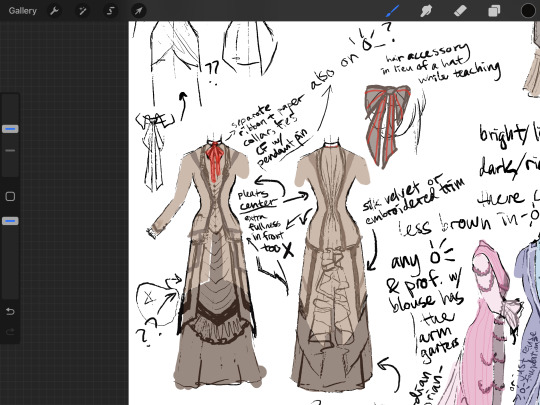
the dominating collar scheme for all the daywear options is brown, and while i could have used more red in accordance with the canon red tie and eyes, i again know that my wardrobe doesnt do red, so that wasnt really a choice in terms of the main body of the dresses if i want to be able to wear any of it normally. This one also needs to have the color layer updated. For the professor outfit, I was keeping in mind a relatively simple/modest design- for a noble lady- but especially in the back where male students would probably see a lot of (since she would be also writing on the blackboard), because anything too complicated or eye-catching could be "distracting". i didnt want to make it too modest because the students and coworkers are also of similar social class to f!william, so there is some expectation of dressing well for her station but also not being too distracting for the young male students :/ i'm still considering toning the design down more, but im not sure how....
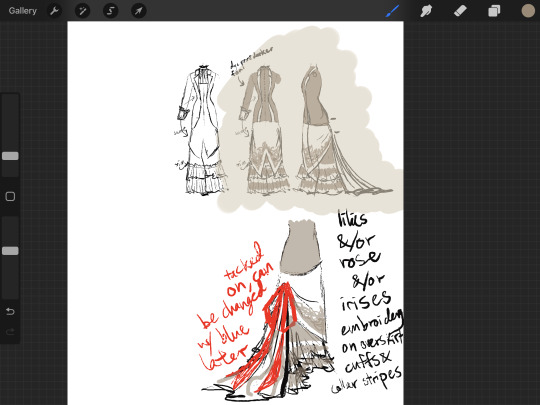
this is what i have for the normal noble lady daywear, hopefully appropriate year-round because i dont feel like designing a new outfit for like all 4 seasons. since it was by far more fashionable for women to wear brighter/lighter colors (usually more adorned by trims in matching/accenting solids rather than patterns for any time of year) during this time if it wasn't winter, in which case it would be dark but still rich colors, i made the browns a lot lighter to compensate for the fact that i'm trying to a. keep close to canon design and b. again, i want to be willing to actually wear it normally, so no reds or pinks as a main part. the big red ribbon will just be tacked on lightly so i can take it off when i'm not cosplaying. I also try to incorporate more of the pressed pleats trims as a nod to william's whole thing about perfectionism, precision, and preparation, as well as him being a math nerd, but like that also ties into the... 3 P's?? so *shrugs*. I also just love the trains of the natural form era so of course I had to add that here, where i can go wildly unpractical, in comparison to the professor one, which does have to account for a good bit of walking by foot across campus and possibly through town. this is also subject to change, but i like to think it's mostly set in stone here.
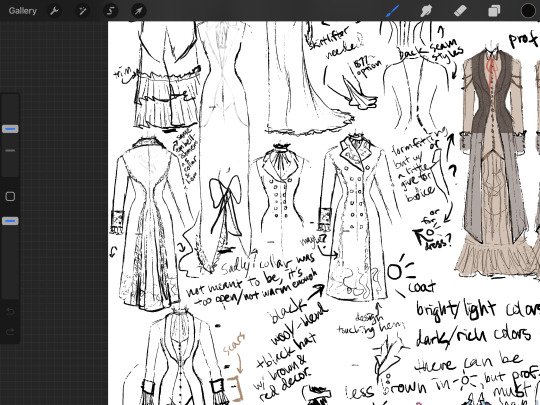
i also designed a black coat as a noblewoman adaptation of the one william wears in canon, which you can see him wearing when he and albert are at adam whitely's park opening speech. I'm not entirely sure about the exact nature and design of the embellishments, but its probably going to be some amalgamation of beadwork and embroidery. i'm actually also going to be making this, straight up because i want a black coat anyways lol. too bad it's not in time for this years winter. i didnt actually draw out the design for the hat but i was planning on a black base hat with brown and red decorations to tie it to any of the daywear clothes, including the coat, and maybe with a sheer white veil in the back? that was in fashion like during at least the mid 1870's. I'm also adapting the cane to an umbrella/parasol. while it'd make more sense to be a delicate litle parasol, i already have a normal-sized black umbrella with a silver metal handle, so that's like a perfect prop that mimics the dark wood cane with a metal handle that william uses in canon, though my umbrella doesn't have a sword hidden in it haha.
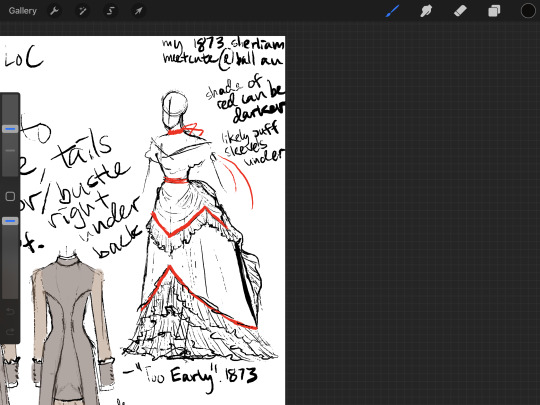
also, as a fun aside, in 1873, there was a brief trend for women to wear a ribbon choker that tied in the back with long tails as an evening wear accessory. so this is a sketch of a painting's outfit, dont remember the name though, that was painted in that year. Correction, I just saw that I wrote it down and its name is “Too Early”. I couldn't help but think up a fun little au of an au where f!william, who would be 18 y/o publicly-known-as-20 y/o, was at a ball and sherlock, male or female? (though i think a female sherlock would be kind of weird considering his canon bias that women are emotional, not as logically intelligent, and delicate :/), was also dragged there by mycroft or something when he decided?? to briefly visit england instead of presumably??? staying at whatever college he was studying at in paris. So, i was originally thinking that it would be such a cool image of sherlock lightly grabbing the tail ends of a red ribbon choker that f!william was wearing with a similar vibe as that sherliam manga vol. 14 cover art, as william turns to look over her shoulder at sherlock. But then, i obviously had to justify it to myself, so i came up with the whole above scenario and i guess they ended up meeting and becoming interested in each other a la canon but earlier and at some point in the night, william was teasingly staying (physically) one step ahead of sherlock and the image is when sherlock finally managed to catch william.
so i guess i'll post updates as i go? i'm definitely estimating this to be a year(s)-long project, considering all the research, patterning, and sewing i'll be doing. i'm also planning on doing a photoshoot with the cosplay when i'm done, so i'll be posting those whenever i have them ready.
edit: I just briefly skimmed a little of the history of female scholars, and apparently the first one to become a professor during the Victorian era is credited to Edith Morley, in 1908 at the age of 33, though there were some other women who also attended a male-dominated college around the same time as her in the 1890’s. Thus, for f!william to have been able to get that professorship or even attend and graduate from a college with a proper degree ~1869-1873, that would have been seen as even more extremely radical, which would have made her stick out in high society in a way that would make it harder to convince targets like lord Enders that she was similarly elitist and a “proper” noblewoman. She also would have had to convince both count Rockwell, her guardian, and the college itself to allow her to attend at ~14 y/o publicly-known-as-16 y/o and maybe even graduate with a proper degree, probably through a lot of machinations on her part, not to even mention being a professor. The only advantage to be found is that she’s seen as a noble, so there is some influence to exert to match male-dominated college chairs.
9 notes
·
View notes
Text
Timeless re-rewatch - s1e02 (because I have no willpower)
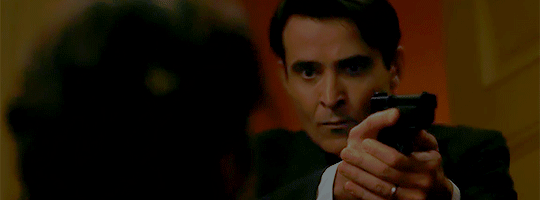
Th Assassination of Abraham Lincoln: so a lot of the US eras/events that Timeless visited, I didn't know much about, being a Brit. However, I did know a fair bit about Abraham Lincoln's end which helped in this ep.
As someone with a keen interest in historical fashion and an occasional costume maker, I love that we get to see Jiya helping Lucy into her 1860s undergarments 👍
Paperweights - you think Connor? 😆
I do love the Timeless intro with the date travelled to each ep featured. Simple but effective.
I like the plotline with Rufus (or Denzel Washington 😁) and the soldiers of colour.
First sighting of Karl, yay! Followed by the the world's worst Irish accent and the world's worst game of Operation 😆
Lucy goes tovthe train station and gets a date for the evening, but there's still more chemistry in the following scene with Flynn, even when they are yelling at each other 😁
Love that dress on Lucy, really want to make a cosplay of that one day 😍
I was unaware of the plot to kill Grant and Seward alongside Lincoln, so that was interesting to learn on first viewing.
The show is certainly not afraid of making Flynn the definitive bad guy at this point, making him kill Abraham Lincoln sermed a bold move! I love that Lucy managed to foil his attempts to change the timeline by killing , even though she's about half his size! The looks on both of their faces when he bursts in though 😱
"I wish I could have saved your father" "There was nothing you could have done" Guilt trip!
The paperweights seem to be working well 😁
I love the looks at the revised histories that they do in most eps and how members of the timeteam sometimes appear in them.
Double bombshell for Lucy at the end 😱😱 She deals with having a sudden fiance she's never met before way better than I would have done!
Starting to get bad vibes about Carol Preston there too 😒
#timeless re-rewatch#timeless#timeless s1e02#timeless - the assassination of abraham lincoln#lucy preston#rufus carlin#wyatt logan#garcia flynn#jiya marri#denise christopher#connor mason#carol preston#noah wyle#noah#abraham lincoln#robert todd lincoln#john wilkes booth#karl
6 notes
·
View notes
Text
The “Victorian” costumes in Warnings at Waverly Academy are a hot mess.

This picture was *supposedly* taken in 1866. Not a single one of these people is dressed appropriately for that year. As someone who has an amateur interest in historical costuming, especially of the Victorian era, this bugs me a lot.
The man, for starters, is wearing a tailcoat in the daytime? That’s black tie evening formal wear my guy. What isn’t formal wear is the waistcoat, which is both too long and too square, or the weird kerchief thing around his neck. If it is meant to be a cravat it is tied incorrectly and the ends should be tucked in.
Of the women, the woman in the center is perhaps the most accurate since she has the “schoolmarm” look although her skirt is entirely wrong and shirtwaists wouldn’t be worn for around another 40 years.
The other women are dressed in dresses appropriate for the very early 1900s (think Anne of Green Gables) with the puff sleeves and less full skirts. None of them seem to be wearing appropriate undergarments for the time period either. Not a crinoline to be seen.
The closest thing to accurate is probably the hats, although the photo quality is lacking enough it’s hard to say for certain.
If these school founders were dressed appropriately, their costumes would be more like these:


Further examples can be seen here:
https://fashionhistory.fitnyc.edu/1866/
https://fashionhistory.fitnyc.edu/1860-1869/
It is just a random picture needed for a clue and I guess I should be glad they got within 50 years ish of being sort of accurate but still, if you’re going to go to the trouble of renting costumes and taking pictures maybe do that extra little bit of research to make them accurate.
#clue crew#her interactive#nancy drew#nancy drew games#wac#warnings at waverly academy#1866#historical costuming fail
81 notes
·
View notes
Text
V I C T O R I A N E R A
The fashion staples-
D r a w e r s - Women of the Victorian era did not wear modern style underwear the either wore drawers (1840-1870) or a chemise (1860-1890). as drawers were the Victorian equivalent to underwear they have a hole in the crotch to allow Victorian women to use the bathroom with their many layers of clothing.
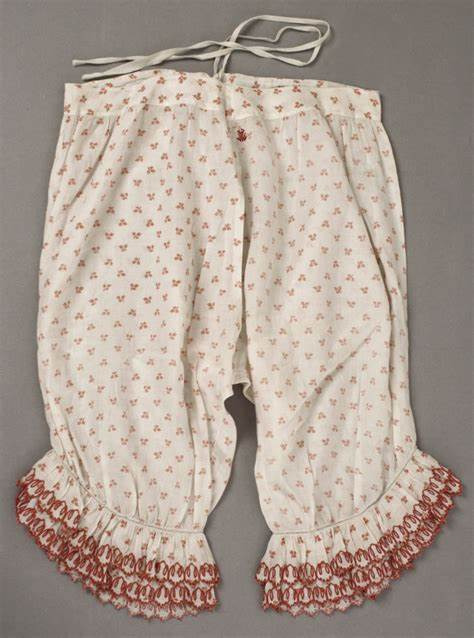
C h e m i s e - The first laying piece worn as an undergarment over drawers was an unshaped garment which reaches just below the knee and typically had a draw string neckline. it added a layer and protected other clothing from sweat and body oils.

C o r s e t s - The word corset originates from an old French word meaning bodice. However Italy was the first country to use the undergarment. The intention to the garment was to create the desired pear/ hour glass figure. Corset was extremely bad for a woman body as all were incredibly tight and some lined with steel, this restricted a woman's breathing and damaged and moved internal organs.

c r i n o l i n e - The crinoline was an undergarment used to create shape and a base for other layers ( such as the petticoat). before the over gown (skirt/dress). the crinoline was a caged/hooped skirt frame which created the effect of fullness for the overgarment.

b u s t l e - the bustle was an undergarment. the bustle like the crinoline created shape however the bustle created fullness at the rear end of the woman. these became popular around 1870 much rather than the typical crinoline shape.
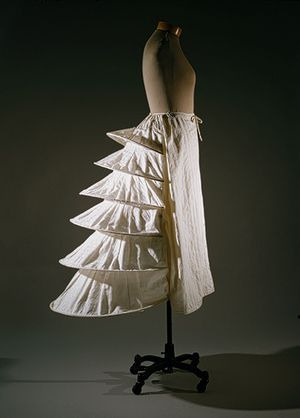
p e t i c o a t - the petticoat was another undergarment. the petticoat was a layer to add shape. often many worn at a time over the crinoline or bustle.

3 notes
·
View notes
Note
Why did the early-mid century culture hate the victorians so much? Was it just "my grandparents lived through it so I associate growing up around this stuff with being outdated and yucky" kinda like how I've seen the 1970s-80s regarded? Or was there something else going on there culturally?
I suspect it's partially that, and partially just. How much everything changed aesthetically in a relatively short span of time.
I mean, if you look at the feminine fashion differences between 1860 and 1880, the trim and silhouette obviously differ greatly but the basic composition of the outfit is the same. Same under-layers, same general bodice-and-skirt format for most dresses, same hemlines, same broad expectation for the hair (long, mostly one-length, natural colors) even though the popular styling of women's updos changed.
and then you look at, say, 1905- Edwardian, but that same general outfit format -to 1925.

(Le Costume Moderne, 1905.)

(The Delineator, 1925.)
There had been radical aesthetic shifts over relatively short periods before- see also: 1780 vs. 1800 -but to my knowledge few of them involved changing the composition of outfits so radically. The 1920s saw the beginning of the now-familiar bra and panties model of conventionally feminine undergarments, for example, as opposed to the immediately prior "chemise and drawers, or combinations, and corset" model. In a very real way, that decade seems to me to have introduced the way we wear clothing today. Obviously some things like girdles and slips have mostly fallen by the wayside, but. It's the beginning of a clothing system that seems vastly more familiar to most of us now than what came before. And with that shift came a lack of understanding of how the earlier model actually worked in everyday life. Combined with new strides being made in women's rights compared to the previous status quo, it could be all too easy to see such totally foreign fashions as awkward and oppressive.
Also it was very much a time that emphasized all things new and exciting, as humans are often wont to do. So the past, and all it represented, cut very little ice. Especially the relatively recent past.
I mean, look at Art Deco and Midcentury Modern. They're basically the polar opposite of Victorian styles that emphasize heavy ornamentation, natural materials, maximalist decor, organic lines, historical inspiration, etc. It's not hard to see that someone raised in that environment might look on the very alien houses- and clothing -of the past and recoil a bit.
And yeah, I think there may have been a bit of a Granny Effect going on- something you grew up associating with fusty old people is bound to have less romance than something you've no direct connection to. Indeed, we do see a bit of Colonial Revival architecture popping up in the 1940s-50s U.S., suggesting that it wasn't necessarily the past as a whole that people of the early-mid 1900s objected to.
(Also, you do occasionally get bits of Victorian nostalgia. Often in the form of art depicting earlier times with varying degrees of accuracy, dolls costumed in past styles ditto, movies set in the mid-late 19th century, recommendations about how to make one or two bits of Victorian furniture into "quaint" statement pieces for a room, etc. Still, it's often a general damnation with faint praise.)
So those are my rough thoughts on the subject!
122 notes
·
View notes